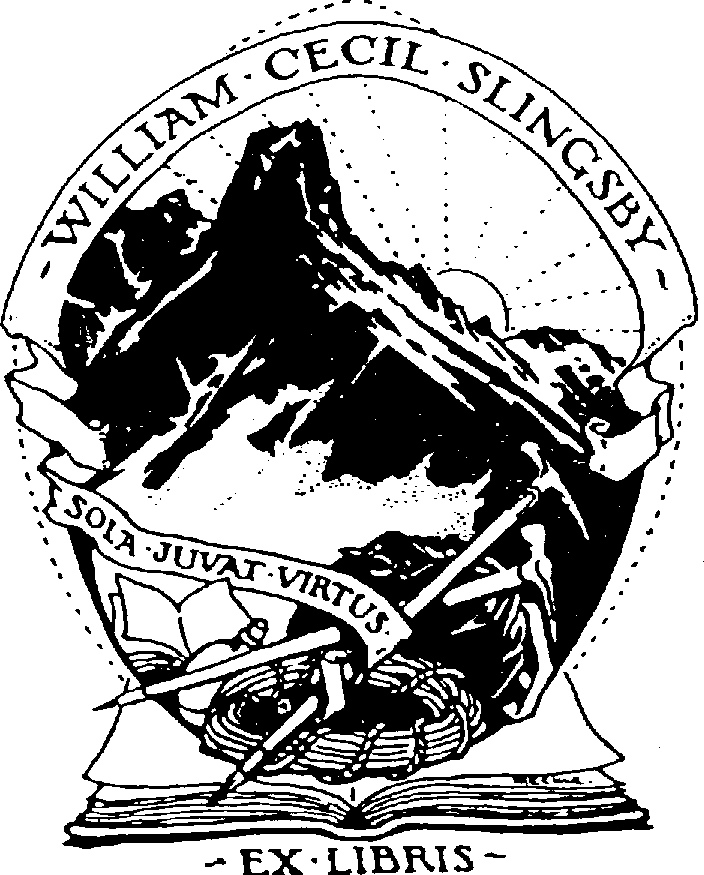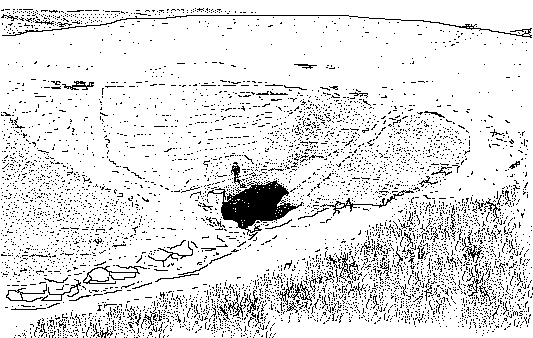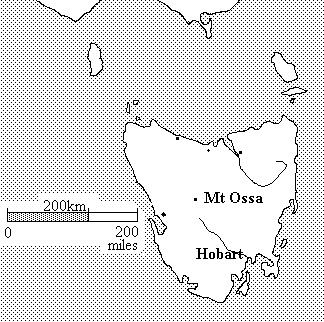Chippings
John Snoad has presented the Club with a framed copy of Slingsby’s book plate.
The peak in the illustration is Stor Skagastølstind (Storen) in the Jotunheimen, Norway.
The Fell & Rock’s library is held at Lancaster University and Temporary Readership is now available to researchers sponsored by the Y.R.C. George Watkins is the F.R.C.C. Librarian and it is suggested that members wanting to use this facility should make the application through our own Secretary.
The contents of their 73 journals have now been placed on a computer database and therefore the search for information in these is that much easier.
The Fell and Rock’s documentary archive is housed in the Cumbria Record Office at Kendal. The archives can be consulted by appointment during normal office hours.
From the 73 F.R.C.C. journals it was expected to record some 2000 entries. The estimated time to enter these records was 75 hours. The Y.R.C. has published 40 journals. Is there anyone out there willing to take up the challenge to record on database our journal contents? It will prove to be a fascinating and worthwhile exercise. Please contact Raymond Harben who can provide further information.
This issue contains a lot of material with a Scandinavian slant. This calls to your editor’s mind a book recommended by Ian Crowther for those who are whiling away a few hours at Lowstern. ‘Two Eggs on my Plate’ by Oluf Reed Olsen, 1954, starts with the invasion of Norway and follows the author’s resistance activities until the bells of peace rang out in 1945. The tales of hidden radios, hideouts and chases in the mountains, false papers, direction-finding radio vans and being caught in a North Sea gale for over a week can be dipped into and are an effortless read. You will find the book in the library at Lowstern.
The the title refers to the extra rations served to agents whose departure on active service was imminent.
In the winter of 1890, shortly before the foundation of our Club, our soon-to-be Honorary Member, W. Martin Conway initiated a grand debate in British climbing circles through an address to the Alpine Club. He tackled the question ‘Why do we climb?’
Some climb to get a better view, he stated, and this can be for scientific or artistic reasons. A further type of climber is curious, wishing to know what it is like to be there. His final type is the Alpine gymnast for whom exertion and skill are the pleasures.
He then moved on to what type of climbing is ‘best’. To do this he examined not the motivation but the method. Centrists establish themselves in a hotel and return daily while others, excentrists, move from place to place at short intervals.
He denounced centrism asserting that the man who wanders “… is more easily able to keep his eye alert and his mind fresh for the appreciation of … beauty.” Today our Club meets include some which encourage mountaineering from unusual bases though many are centrist in approach.
Conway avoided centrism with a vengance. He wandered round far-flung ranges from the Andes to the Karakoram. During 1894 he traversed the Alps, over 1000 miles in 65 days, from the Maritime Alps to the Grossglockner including 21 peaks and 39 passes. Certainly excentrist.
Incidentally Conway threw in the assertion that the drive to climb is stronger in those whose homes are in flatter areas. In a deep valley they feel imprisoned and are impelled to escape upward.
David Smith draws to our attention his first encounter with that much respected doyen of the Club, Ernest Roberts who told David that the editor of the CPC journal had actually spelt Gaping Gill, Gaping Ghyll (rhymes with while). Quite incorrect Roberts advised. Now there remain just 68 ancient (David’s term your editor hastens to point out) members who had the good fortune of listening to the wisdom of that venerable Yorkshire Rambler.
In the recent issue of the Fell & Rock Chronicle, their guidebook editor advises his members that new editions of guide books will have the word spelt the correct or Robert’s way, Gill. He was of course right as he invariably was. His spelling of the word comes from the Old Norse. The Ghyll spelling was little more than the fanciful creation of an 18th century poet, probably Wordsworth.
Members who are cyclists, or given the tale of woe portrayed, those who have sensibly avoided cycling, may be interested in a Jeri Harrap’s slim book recollecting her own introduction to the Barnsley cycling scene. The descriptions of Highland Youth Hostel tours in the rain will strike a chord with many members. ‘Jeri’s Journals, the diary of a rubbish cyclist’ costs £4.25 (inc. p&p). Telephone Jeri Harrap on 0114-2864418 for details.
In response to last issues request for assistance in identifying the signatures on the ‘Wigwam’ sketch, Jeffrey Hooper has identified several as members.
1 G.T. Lowe, elected 1892, died 1942
3 Lewis Moore, elected 1892, died 1993
5 J.Towers, elected 1892, resigned 1893
13 Percy Robinson, elected 1906, died 1948
15 Frank Dean, elected 1892, resigned 1895
29 Alexander Cambell, elected 1903, died 1941. He is referred to, in the Journal, as being the pianist at the Annual Dinner, February 1903
Other signatories he identified were not members.
7 William Carter
8 W. Scuriato
14 F.M. Curran(s)
17 Frank Atthaiss
18 George I Barley
20 ?. Forbes
31 William Jones
Jeff had seen the sketch previously when classifying a two foot high pile of Roberts’ papers. He believes the ‘Wigwam’ group to have been a dining or smoking club not directly connected with the Y R C.
It has been suggested that the best and more important bits of these Bulletins could, from time to time, be re-published in a form similar to the Journals and sold to members at cost. The cost might be about £8/10. Comments please to the Committee.
Reacting to a study of the use of ski poles in a recent Bulletin (Issue 2, page 20) Derek Smithson thought it might be of interest to other members to see what was said on the matter over a hundred years ago.
“When a man who is not a born mountaineer gets upon the side of a mountain, he speedily finds out that walking is an art; and very soon wishes that he could be a quadruped or a centipede, or anything except a biped; but, there is a difficulty in satisfying these very natural desires, he ultimately procures an alpenstock and turns himself into a tripod. This simple implement is invaluable to a mountaineer, and when he is parted from it involuntarily (and who has not been?) he is inclined to say, just as one may remark of other friends, ‘You were only a stick – a poor stick – but you were a true friend, and I should like to be in your company again.’
A volume might be written upon the use of the alpenstock. Its principal use is as a third leg, to extend ones base line; and when the beginner gets this well into his head he finds the implement of extraordinary value. In these latter times the pure and simple alpenstock has gone out of fashion, and mountaineers now almost universally carry a stick with a point at one end and an axe-head at the other. ”
Derek’s quotation is taken from ‘The Ascent of the Matterhorn’ Edward Whymper, published in 1880
David Laughton was very interested to see, in issue 3, Peter Lockwood’s ‘Newfoundland Notes’ as he already planned a trip to Newfoundland and other Canadian Atlantic Provinces for June 1995. Unfortunately this visit did not provide much hill walking but he did meet Peter in St. Johns, saw much superb coastal scenery including several National parks and went out on three whale watching trips.
David certainly confirms Peter’s final comment ‘Newfoundland is worth a visit’ and would add that the same applies to Nova Scotia, New Brunswick and Prince Edward Island.
Ian Crowther made a three day trip this summer starting on foot from Low Hall Garth and bivvying out the first night on Stake Pass and the second on Caudale Moor (above Brothers Water). He ended his unsupported tour at Ravenstonedale, North of Sedbergh. This might well classify Ian as an excentrist.
Harry Robinson spent six months avoiding Britain’s driest and warmest summer for many years by going to Australia. He spent time in Glen Elg near Adelaide and Tasmania.
The latter is dominated by a continuation of Austrialia’s Great Dividing Range, South from the mainland. The highest point on Tasmania is Mount Ossa (1617 m / 5305 ft), located on a, high central plateau, with many lakes and several rivers. Harry reports that the mountains are a higher and harder version of the Scottish Highlands and suitable for Club members to explore further.
Jon Riley is expected to be returning, in mid December, from his spell in Spain to be working in his own business.
Anyone interested in the following pieces of equipment should contact Derek Smithson who is, I think, willing to give them to any deserving home: Zenith SLR with no automatic features to go wrong or confuse; extra lenses and a light meter for the camera; 1957 Super Aldisette slide projector taking ane slide at a time; numberous mountaineering slides; traditional Norwegian snow shoes.




